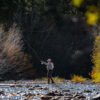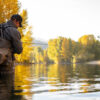Synopsis
With the fall colors upon us, now is one of our favorite times to hit the local waters. When fishing, remember to stay simple and cover water. One fish here may not eat what another fish there will. Spread yourself out and find fresh fish. Keep a watchful eye for natural insects, but do not be afraid to use attractors. With winter on the stoop, trout are trying to fatten up, but after being targets for fisherman all summer, they’ll be wary. Accurate but delicate presentations and discreet water selections will most translate to success. Also, don’t forget to bring your camera!
Silver Creek
As the season takes a final nod towards winter, anglers will find less insect activity with each passing week, and the fishing will gradually be replaced with duck hunting. Baetis and Midges are the final hatches of the season. Look for cloud cover, a rise in humidity, or the passing of a storm to bring out the thick clouds of Baetis. You also may spot a few remaining Mahogany Duns. These can often get lost in the heavier hatches of the emerging Baetis and Midges, so pay close attention to what the trout are eating. In addition, try throwing a Hopper. Though the frosts of last week have killed most of the population, there are still a few about, and the trout will remember. A black or brown Crowe Beetle is an option too. Regardless, the best action will likely come from casting a well-tied Mahogany Dun or Baetis, fished on a long, light leader. As the Conservancy fish look to bulk up for the winter, remember they have been targeted all summer, so you may find them quite wary.
Big Wood River
Warm fall days mixed with bright colors make an excellent backdrop for the remaining hatches of Baetis and Midges. A few October Caddis may be seen north of town in the afternoons, but the presence of natural insects is quickly falling off. Large attractor patterns can be very successful this time of the year. A Parachute Adams, Royal Wulff, Royal Stimulator, or H & L Variant in a size 12 or 14 can be a good selection, but make sure to cover lots of water. Dry-dropper combinations are great choice as well, with small Pheasant Tails and Zebra Midges in tow. Furthermore, swinging a larger nymph like a Hare’s Ear or Soft Hackle, or a wooly-bugger streamer through the deeper runs may produce good results.
Upper Lost and Copper Basin
If you decide to fish up here, stay light on your feet and offer only a few minutes to each hole. Small attractor and nymph patterns such as Adams Parachutes, Irresistibles, Stimulators, Copper Johns, and Golden Stoneflies are worth a try.
Big Lost River
Below the Dam, the Big Lost is running at a meager 57 CFS. The low water level will mean long, light leaders, careful presentations, and silent approaches. Look for the large rainbows to be in the shallower sections, on the shoulders of the runs, and sipping in the softer water. Some Baetis activity can be seen from mid-morning through after lunch. If you can not get them on top, small nymphs can also produce hookups. Use a light leader and tippet here as well, with Zebra Midges, Pheasant Tails, King Princes, and Copper Johns.
Little Wood River
No reports on the Little Wood. Expect low flows, smaller fish, and success to come from small attractor patterns and small nymphs. Streamers may be the most productive selection of all.
South Fork of the Boise
Water levels have been down to 300 CFS for the last couple weeks. With the drop comes accessible walk and wade conditions. Look for Baetis on the cloudy days and PMDs on the sunny ones. Both these insects are quite small, around size 18 and 20, and will generally come off in the afternoon, 3-4 PM. Target rising fish in the slow water, and watch for subtle takes at the seams and heads of runs. Sparkle Duns and Hackle Stackers are good choices for Baetis, and light-colored Cripples and No Hackles work well for the PMDs. Nymphing is always a strong candidate on the South Fork. San Juan Worms, Girdle Bugs, and Soft Hackles can get you hook-ups, but a good portion of which will likely be Whitefish.



